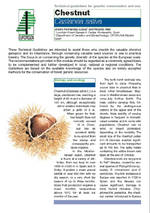Castanea sativa - Technical guidelines for genetic conservation and use for chestnut
This publication has been translated into the following languages:
Slovenian Italian Spanish
The first step to ensure the conservation and sustainable use of chestnut genetic resources in Europe is to assess, for each country, the present and past geographical distribution of the species, the conservation status, to identify threats and the prevailing or potential uses. Inventories should be undertaken in countries where the distribution of the species in the wild is unknown. Historical data may be required to distinguish the natural distribution range from the naturalized populations. Ecological gradients could be used to define ecogeographic zones or regions of provenance where the species is seed propagated.
For in situ conservation of populations, several managed stands should be designated from those selected for seed production (seed stands), with at least 100 trees that fruit regularly in each. These populations should then be sampled for provenance testing. If the populations are small (less than 20 trees), then seeds from several different populations within an ecogeographic zone should be collected and mixed, and the seedlings produced should be planted in the in situ gene conservation population to enhance their genetic diversity. If this is not possible, the number of trees in the population should be increased by planting material according to data from provenance trials where available, or by introducing individuals from similar ecological conditions. Different conservation populations should be established for nut and wood production.
A Multiple Population Breeding System (MPBS) is recommended to conserve the genetic diversity in wild populations (Ideally in MPBS, a breeding population is subdivided into subpopulations which are then grown over a wide range of site conditions. Each subpopulation may have the same or different breeding goal. In less intensive version of MPBS, subpopulations are selected from existing forests instead of establishing ex situ stands of the subpopulations). To create a European network of gene conservation stands, at least 30 (‘undomesticated’) stands should be selected throughout the distribution area, with greater numbers representing Castanea sativa. Guidelines for genetic conservation and use marginal populations. Sub-populations should be managed to promote nut production in trees with desirable phenotypes.
Cultivated varieties should be conserved in clonal archives. Clonal archives of plus trees and local fruit varieties can be considered as sub-populations within a Multiple Population Breeding System, with the main objectives of breeding and preserving the present composition of the chestnut forest stands and orchards. The aim is to prevent disappearance due to disease or dysgenic selection. Since two hybridizing species confer disease tolerance to C. sativa, it is recommended to include material from plus trees of C. crenata and C. molissima in clonal archives, located in areas without pronounced drought.
For ex situ conservation, provenance tests should be established in contrasting, disease free environments. Aiming firstly at studying the variability of the adaptive traits and then to conserve the material, progeny tests of selected plus trees from several populations should be set up on sites where a breeding programme will be implemented. One of the populations will serve as a control, to be tested in different environments, and the others will be included depending on the needs and priorities of every country.
Authors: Josefa Fernández-López; Ricardo Alía
Journal/Series: EUFORGEN Technical Guidelines for Genetic Conservation and Use
Publication Year: 2003
Publication Format: Folder; PDF
ISBN: 92-9043-606-9
ISBN 13: 978-92-9043-606-5
Language: EN
Pages: 6 p.

